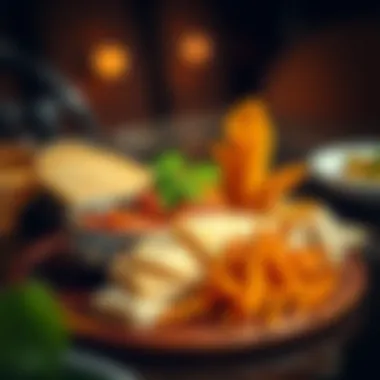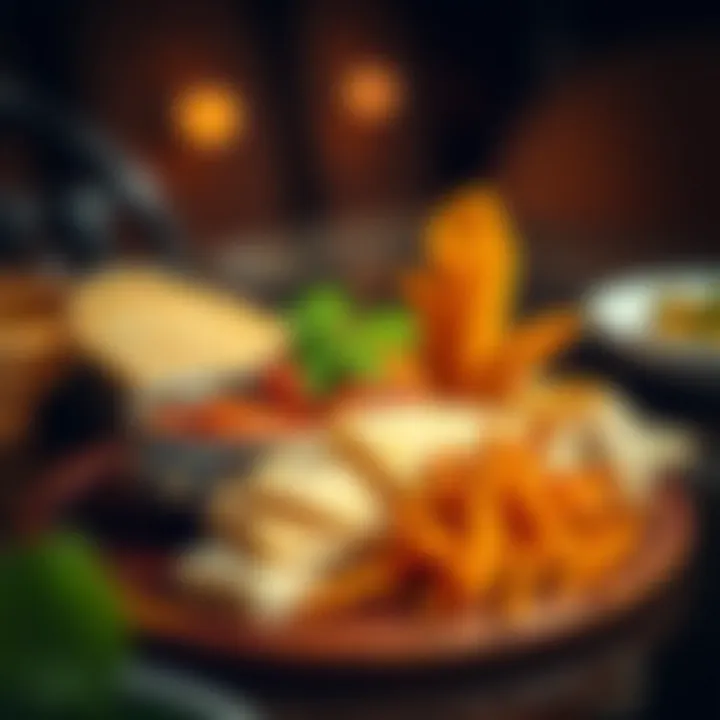Top Indian Dining Experiences in Dubai


Intro
Dubai's culinary landscape shines with diversity, and among the myriad of flavors, Indian cuisine holds a place of honor. This vibrant city attracts food lovers not just for its glitzy skyscrapers but also for its rich tapestry of dining experiences. From the traditional to the contemporary, the Indian restaurants in Dubai cater to a wide array of palates, making it essential for diners to navigate through this vast culinary terrain.
With an ever-increasing demand for authentic Indian dishes, restaurant owners are not merely serving food, but crafting experiences that reflect the essence of Indian culture. Whether one craves a spicy biryani, a rich paneer butter masala, or freshly made naan, these eateries promise both tantalizing flavors and welcoming atmospheres. As you traverse through this guide, you'll uncover not just where to eat, but also the stories behind why each restaurant stands out amidst a bustling food scene.
From family-run joints that have been perfecting their recipes for generations to upscale establishments that give a modern twist to traditional dishes, this exploration is set to illuminate the core of Indian gastronomy in Dubai.
"Food is not just about sustenance; it’s about connection, culture, and community."
As we delve deeper, you’ll gain insights into the unique offerings, special dishes, and the overall dining experience that make Dubai's Indian restaurants a must-visit for any food enthusiast.
Overview of Indian Cuisine in Dubai
Indian cuisine in Dubai serves as a gastronomic bridge connecting a diverse blend of tastes and traditions. This is vital not just for those who relish the array of dishes but also for understanding the layers of cultural melding that happen within the bustling food scene of the city. As the Indian diaspora expanded and established roots in Dubai, they brought with them culinary gems that transformed the dining landscape. From vibrant spices to age-old recipes shared across generations, the uniqueness of Indian food in Dubai resonates through the numerous restaurants scattered throughout the city.
Historical Context
The historical context of Indian cuisine in Dubai traces back to the early 20th century when traders and migrants from the Indian subcontinent began to form a significant part of the UAE’s population. These communities took their culinary traditions onboard ships and bustling markets, blending their flavors with local techniques and ingredients. Early establishments were humble, usually family-run spots offering authentic home-cooked meals to the expatriate workforce. It is this humble beginning that paved the way for what has become a booming sector of luxury dining experiences intertwined with tradition. Just as a dish layers its flavors, the historical journey of Indian cuisine in Dubai illustrates a rich tapestry woven from various cultural threads.
Fusion Trends
In recent years, the culinary scene in Dubai has flourished with fusion trends that blend traditional Indian recipes with elements of other cuisines. This adventurous approach resonates with a youthful audience that appreciates novelty, resulting in dishes that tantalize the palate while offering a playful twist on time-honored classics. Take the butter chicken tacos or a palak paneer pizza, for instance, where chefs bend the rules of gastronomy without losing the essence of the original dish. Notably, fusion trends aren't simply about unusual pairings; they also reflect the cosmopolitan nature of Dubai itself, attracting food enthusiasts eager for new taste experiences.
“Fusion in Dubai is like a melting pot—every bite tells a story of culinary mingling.”
Moreover, restaurants often infuse elements from Middle Eastern influences, creatively incorporating spices such as za'atar or sumac into traditional Indian dishes. This not only appeals to a broader audience but also keeps the essence of Indian cooking alive, ensuring that every dish has its signature fingerprint amid fluctuating trends. A meal in Dubai can thus become a culinary journey across continents, making Indian cuisine here a vibrant part of the city's multicultural landscape.
Key Characteristics of Indian Food
Exploring the key characteristics of Indian food is essential to understanding why this cuisine has taken root and flourished so vibrantly in Dubai's dining scene. A melting pot of spices, regional variations, and deep-rooted cultural significance creates a rich tapestry that not only pleases the palate but also tells the story of its people.
Spices and Flavors
The beauty of Indian cuisine largely lies in its use of spices, a hallmark that distinguishes its flavor profile from others around the world. Spices like cumin, coriander, turmeric, and cardamom are not just ingredients but a celebration of flavors that dance on the taste buds. They can elevate a simple dish into something extraordinary, drawing diners into an experience rather than just a meal.
The layering of flavors is crucial. Take the classic biryani, for instance. It’s not merely rice and meat but a symphony of spice notes, where saffron, cloves, and the aromatic steam meld together to create a dish that's savory and fragrant. You’ll often hear Indian chefs talk about "tempering" spices—cooking them in hot oil before adding them to the dish—to bring out their full potential. This technique infuses dishes like dal and curries with depth and dimension, making each bite a delightful exploration.
"In Indian cooking, spices are the soul of the dish, each one telling a different story and bringing unique nuances to the table."
Diverse Regional Cuisines
India’s vast geography and multi-ethnic society manifest themselves in its regional cuisines, each boasting distinct ingredients and cooking methods. From the creamy gravies of North India featuring paneer and abundant dairy, to the fiery, coconut-laden seafood dishes of South India, the variety is nothing short of remarkable.
In Dubai's Indian restaurants, you can travel across the subcontinent without ever leaving your seat. For foods from Punjab, you might find tandoori chicken and butter naan as staples, while the coastal flavors of Kerala bring dishes like fish moilee and appam into play. Even within a restaurant's menu, you may see a mix that embraces both Mughlai and Chettinad styles, a celebration reflecting India’s culinary diversity and ability to amalgamate.
Cultural Significance
Indian cuisine is deeply interwoven with cultural traditions and societal values. Each dish often carries narratives from festivals, family gatherings, and regional rituals. Food holds an important place in India's social fabric.
Consider the festivals, such as Diwali or Eid, where families prepare specific dishes to signify joy and togetherness. In many Indian homes, cooking is viewed as an art form, passed down through generations—recipes are often closely guarded family secrets, whispered from grandmother to grandchild. This cultural backdrop adds weight to the dining experience in Dubai, where Indian restaurants cater not just to taste but to a cultural journey.
Furthermore, sharing food is an act of connection. The communal style of dining, seen in the sharing of thalis (a platter of various dishes), symbolizes hospitality and warmth, which many Dubai diners find appealing. In this context, Indian food becomes more than just a meal; it creates bonds and nurtures community.
As diners engage with these key characteristics of Indian cuisine, they aren’t merely indulging their taste buds; they are also participating in a rich cultural practice, making their dining experiences in Dubai multidimensional.
The Indian Dining Landscape in Dubai
The Indian dining scene in Dubai is not just a collection of restaurants; it represents a vibrant tapestry woven from the threads of tradition, taste, and transformation. With the Indian community being one of the largest expatriate groups in the city, the demand for authentic Indian cuisine has led to a flourishing landscape filled with diverse dining options. This article sheds light on this culinary phenomenon, focusing on different types of establishments and popular neighborhoods where each bite tells a story.
Indian cuisine is varied and nuanced, influenced by various regional delights, local cultures, and culinary practices. The nuances of dining within this cultural framework lead us to explore the types of Indian restaurants available, each offering unique dining experiences suited to different occasions and preferences.


Types of Indian Restaurants
Casual Dining
Casual dining restaurants have carved out a niche that caters to families and groups looking for a laid-back environment without sacrificing taste. With a cozy atmosphere, these places often showcase simpler yet authentic dishes that echo familiar home recipes. The value for money is a significant draw, offering diners hearty meals without the hefty price tag.
One aspect that stands out is their approach to serving food. Many casual dining spots allow you to share several dishes, making meals a communal experience. Whether it’s a plate of butter chicken or a spread of biryani, the focus is on bringing people together. The ambiance is usually informal, with colorful furnishings and open spaces, making it a favorite for families with children and groups of friends alike.
Pros: Affordable prices and family-friendly.
Cons: May lack luxury service and atmosphere found in fine dining.
Fine Dining
In a city known for its luxury, fine dining Indian restaurants stand as culinary temples where food becomes art. These establishments present Indian dishes with a contemporary twist and often use high-quality, locally-sourced ingredients. The emphasis isn’t just on taste but also on presentation and the overall eating experience. Expect to be seated in elegantly designed spaces that complement the sophisticated menu.
The hallmark of fine dining is the attention to detail, from the carefully curated wine pairings to the thoughtful service that enhances your experience. The chefs here often come with extensive backgrounds, having trained in esteemed culinary schools, and many innovate by integrating elements from other cuisines.
Pros: Elevated culinary experience and exquisite ambience.
Cons: Higher price ranges might limit accessibility.
Street Food Inspired
Street food inspired restaurants are emerging as a popular choice, capturing the essence of India’s bustling street cuisine and bringing it to the urban magic of Dubai. These places often recreate the vibrant street food culture found in cities like Mumbai or Delhi, delivering a burst of flavors and textures. This type of dining is particularly attractive to those who want casual yet thrilling meals that resonate with nostalgia and authenticity.
What stands out about these eateries is their ability to adapt traditional recipes for a modern audience, making use of innovative plating and youthful energy. The dishes can range from spicy chaat to grilled kebabs, and many offer tasting menus to enjoy multiple flavors in one sitting. This makes it a fun choice, especially for those eager to explore new tastes in a more informal setting.
Pros: Fun experience and a variety of flavors in an informal ambiance.
Cons: May not always guarantee authentic taste due to adaptations.
Popular Neighborhoods for Indian Cuisine
Bur Dubai
Bur Dubai is often regarded as the heart of Indian dining in Dubai. Steeped in history and culture, it is a neighborhood where the rich flavors and aromas of Indian spices fill the air. This area is celebrated for its authentic eateries that have stood the test of time, preserving traditions while catering to modern tastes.
The diversity available here is astounding, from classic curries to dosas. Furthermore, this neighborhood is an affordable dining destination, making it accessible for those looking to enjoy authentic meals without overspending. With bustling markets and a mix of cultures, dining in Bur Dubai feels like taking a culinary tour of India itself.
Pros: Affordable and authentic, great cultural experience.
Cons: Some places might lack modern aesthetics.
Jumeirah
On the other end of the spectrum lies Jumeirah, an affluent neighborhood that showcases Indian cuisine in a more upscale context. Home to a range of luxurious Indian restaurants, this area focuses on providing high-end dining experiences with superb service. The atmosphere is often plush, complemented by stunning views.
The culinary offerings meld tradition with modernity, making dining here a memorable occasion for special events. While it might come with a higher price tag, the culinary creativity and ambiance make it worth the splurge.
Pros: Upscale dining experience and great views.
Cons: Higher prices may deter casual diners.
Downtown Dubai
Downtown Dubai stands as a testament to modernity and luxury, and its Indian restaurants echo this ethos. Here, you can find a delightful fusion of global and Indian flavors. These eateries are often situated in some of the city’s most iconic buildings, offering patrons a chance to indulge in culinary delights while enjoying stunning panoramic views of the Burj Khalifa and the Dubai Fountain.
Dining in Downtown is about the experience as much as it is about the food. The blend of leisure and taste creates an inviting landscape for food lovers looking for more than just a meal.
Pros: Luxurious ambiance and stunning city views.
Cons: Prices may be on the higher side, limiting frequent visits.
Noteworthy Indian Restaurants in Dubai
The culinary landscape of Dubai is peppered with Indian restaurants that not only serve diverse and authentic dishes but also reflect the culture, history, and modern trends of Indian cooking. Whether it's a dish steeped in tradition or a contemporary twist, these restaurants showcase the richness of Indian gastronomy. Highlighting noteworthy Indian restaurants is essential to this article, as it offers readers a curated glimpse into the best that Dubai has to offer, catering to their palate and creating memorable dining experiences.
Iconic Establishments
Restaurant Name: Cuisine Specialties
One cannot discuss Indian dining in Dubai without mentioning Bukhara, famed for its clay oven (tandoor) specialties. The restaurant offers an array of dishes that coalesce the flavors of Northern India with an essence of authenticity, making it a hotspot for curry aficionados. The rich, marinated meats, particularly the Dal Bukhara, slow-cooked to perfection, is a testament to the restaurant's dedication to time-honored cooking techniques.


It's especially popular among visitors looking for a true taste of India, melding familiar tastes with local flair. Advantageously, its location in a five-star hotel adds an extra layer of luxury, providing diners with a plush atmosphere while enjoying their meals.
Restaurant Name: Atmosphere and Ambiance
If ambiance is a deciding factor, you can't go wrong with Zafran, where the culinary experience transcends mere dining. The chic interiors, enriched with a modern design infused with traditional Indian decor, create a welcoming yet upscale environment. The clean lines of contemporary art juxtaposed against Indian motifs give it a unique twist.
The soft lighting enhances intimacy, making it a great spot for both cozy dinners and festive gatherings. This vibrant atmosphere draws in crowds and fosters a warm, inviting experience. The downside may be the slightly higher price point, yet the overall dining experience is often viewed as worth every penny by those seeking a special night out.
Emerging Stars
Restaurant Name: Unique Offerings
A true standout in the realm of modern Indian cuisine is Rasoi. This restaurant marries traditional recipes with innovative presentation and modern flair. What sets it apart is its adventurous menu that includes gourmet twists on classic dishes, like Khao Suey, a Burmese-inspired curry, showcasing the diversity within Indian culinary traditions.
Rasoi appeals to foodies seeking a break from conventional offerings and pushing the envelope of what Indian food can be. Its unique dishes not only tantalize the taste buds but also keep diners coming back for new experiences, although purists might find some options too divergent from traditional recipes.
Restaurant Name: Chef Background
Delving into the backstory, Masala Kitchen finds its strength through the expertise of its head chef, who has trained in various prestigious kitchens across India and abroad. His understanding of both regional flavors and international culinary techniques informs the menu in remarkable ways.
By integrating diverse influences into the dishes, Masala Kitchen offers patrons an educational journey alongside a gastronomic one. The chef's unique approach, blending the classic with the contemporary, makes it a fascinating place to visit. However, the complex combinations might not appeal to those hoping for simpler, traditional tastes.
Hidden Gems
Tucked away in the quieter neighborhoods of Dubai are several lesser-known treasures like Ajwa, famous for its lunch thalis that reflect the vibrant street food culture of India. The cozy setup and authentic flavors remind diners of home-cooked Indian meals, making it a beloved spot for both locals and expatriates.
The Role of Indian Cuisine in Dubai's Culture
Indian cuisine isn't just a menu in Dubai; it's a vibrant thread woven into the very fabric of the city's culture. The influence of Indian food extends far beyond taste—it reflects a rich heritage, community ties, and a growing fusion with various international flavors. As diverse as the people who inhabit the city, from expats to natives, Indian culinary offerings mark a space that celebrates heritage while embracing modernity.
Community Influence
The Indian community in Dubai is one of the largest expatriate groups, and naturally, its culinary practices have left a lasting impact. Restaurants are more than mere places to eat; they serve as communal hubs where discussions spark, businesses are built, and friendships thrive. Places like Ravi Restaurant or Bikanervala are packed to the brim, serving not only food but a sense of belonging.
The menus often feature a mix of regional cuisines, reflecting the varied backgrounds of diners. For instance, you'll find Mumbai-style chai in one corner and Hyderabadi biryani in another. This melting pot of flavors represents the blend of cultures that characterize Dubai.
"Food is a common ground, a universal experience that transcends barriers."
— Kiran Sharma, Food Blogger
Festivals and Celebrations
Food plays a pivotal role during festivals, amplifying the cultural experience. Indian celebratory feasts like Diwali and Eid see an explosion of flavors, aromas, and community spirit. Street-side stalls selling sweets and delicacies spring up, and traditional dishes become a focal point of gatherings.
During Diwali, for instance, restaurants might offer special thali menus incorporating rich dishes like paneer butter masala and gulab jamun, allowing people to experience an authentic taste of home, even when they are miles away. Events organized around these occasions draw in crowds, serving as an outlet for shared joy and strengthened relationships.
Additionally, these celebrations offer an opportunity for others in Dubai to taste and appreciate Indian flavors, thereby bridging cultural gaps. This cross-cultural exchange enriches the broader dining landscape, enticing a range of palates and encouraging a spirit of inclusivity.
In essence, Indian cuisine in Dubai is a reflection of diversity and unity, celebrating not only spices and flavors but the stories and traditions behind them.
Dining Etiquette in Indian Restaurants
Dining at Indian restaurants, especially in a melting pot like Dubai, is not just about enjoying delicious food. It's an experience steeped in tradition and cultural significance. Understanding and observing dining etiquette can enhance the overall experience, conveying respect for the culinary heritage and the diverse community that thrives in the city. This section aims to elucidate the important aspects of etiquette, both traditional and modern, guiding patrons to immerse themselves fully in the flavors of India without stepping on any toes.
Traditional Customs
In Indian culture, the act of sharing food is deeply symbolic. It fosters community and fosters bonds among friends, families, and even strangers. When dining at an Indian restaurant, there are some traditional customs that one should keep in mind:
- Hands or Utensils? Traditionally, Indians eat with their hands. While most restaurants provide cutlery, if you wish to embrace authenticity, using your fingers is encouraged. Just remember to only use your right hand; the left hand is considered impolite for eating. Pouring water from a communal jug or sharing dishes directly from one plate to another can be seen as an act of generosity.
- Respect the Arrival of Food: If you're dining with multiple people, wait until everyone has received their food before starting to eat. This practice shows respect to others and respects the meal.
- Meal Order: Typically, meals follow a certain order–beginning with appetizers, main courses, and then dessert. Not adhering to this order can be perceived as haste in enjoying the meal.
These customs might seem unconventional to those unfamiliar, but adhering to them can significantly enhance the atmosphere of sharing and togetherness.
Modern Practices


As Indian restaurants in Dubai cater to a diverse clientele, modern dining etiquette is often influenced by the multicultural landscape. Here are some contemporary practices that harmonize tradition with urban dining standards:
- Dining Alone or with Company: Many individuals may opt for solo dining in a bustling city and Indian restaurants accommodate this well. It’s common to see people savoring their favorite dishes at the bar or communal tables. Whether dining alone or with friends, be mindful of your table manners, as maintaining etiquette reflects well on you.
- Social Media Savvy: In today’s digital age, it’s not unusual for food enthusiasts to whip out their phones and capture their meals. However, keep conversations at a moderate level and avoid lingering too long at your table after the meal, especially if it’s busy.
- Tipping Practices: Leaving a small tip, generally about 10-15%, is becoming more accepted in Indian dining establishments. This practice is a nod to service staff who work diligently to ensure an enjoyable experience.
Understanding these nuances is helpful for both locals and visitors alike. Dining at Indian establishments in Dubai is more than just a meal; it's a social interaction where food serves as a conversation starter, a bridge between cultures, and a medium of shared heritage.
"Dining is an opportunity to connect, not only with food but with the stories and traditions it carries."
For those keen on delving deeper into the rich tapestry that Indian cuisine weaves in Dubai, consider checking resources like Wikipedia and Britannica. These sites provide an expansive look at the roots of Indian food.
Challenges Faced by Indian Restaurants
In a city as dynamic as Dubai, where gastronomic trends shift faster than the sands of the desert, Indian restaurants encounter a myriad of hurdles. Understanding these challenges offers crucial insights not just for restaurateurs, but also for investors, buyers, and culinary aficionados alike. The Indian dining scene in Dubai, while vibrant, is not without its tribulations, rooted in economic pressures as well as the continual quest to maintain authenticity amidst diverse tastes.
Economic Pressures
Economic pressures are a significant factor influencing Indian restaurants in Dubai. The rising costs of ingredients, coupled with the volatile nature of the economy, places owners in a tight spot. Rising rents in prime locations eat into the profit margins, and competition intensifies as more players enter the scene, each eager to carve a niche. For instance, the cost of premium spices, which are essential to maintain the rich palette of Indian cuisine, has seen exponential increases. Many restaurants find themselves torn between keeping prices affordable for customers and ensuring a sustainable business model.
- The influence of global markets on spice prices can impose sudden financial strains.
- Managing costs effectively means sourcing ingredients without compromising quality, which is easier said than done.
Furthermore, customer expectations are continually changing. With a higher number of diners seeking not just good food but a complete experience, restaurants must invest in ambiance, service quality, and innovative menu options. This adds an additional layer to operational costs, often making it challenging for long-standing establishments to pivot without risking their core identity.
"Many restaurateurs find themselves walking a tightrope, balancing financial viability while striving to offer diners an experience they won’t soon forget."
Maintaining Authenticity
The quest to maintain authenticity is perhaps one of the most pressing concerns for Indian restaurants in Dubai. As the city's culinary landscape diversifies, diners are exposed to a blend of global cuisines, creating a demand for innovation. Yet, there lies a delicate balance between adapting to local tastes and remaining true to traditional Indian flavors.
This challenge forces many chefs to reconsider their menus. For instance, while dishes like butter chicken and biryani are staples loved by many, there’s a temptation to modify them to cater to a broader demographic. Yet, this risks alienating traditionalists who yearn for the genuine experience of Indian food. Some establishments navigate this by offering both classic dishes and contemporary interpretations, thus broadening their appeal without fully compromising authenticity.
- Community feedback plays a critical role in guiding how far a restaurant can go while still being seen as an authentic Indian eatery.
- Adapting recipes or cooking techniques can sometimes lead to a loss in flavor and heritage, which is a risk not everyone is willing to take.
The Future of Indian Cuisine in Dubai
The evolution of Indian cuisine in Dubai is not just about maintaining tradition; it’s about adapting and innovating in a rapidly developing culinary landscape. As the city continues to grow as a global dining hub, Indian cuisine must balance authenticity with modern trends, and that’s where the future lies. Understanding the nuances of what’s ahead can help investors, chefs, and consumers alike navigate this vibrant food territory. The increasing competition means that today’s establishments have to be agile, responsive to consumer preferences, and aware of global culinary movements.
As the demographic landscape shifts, with more expatriates and tourists flocking to the emirate, there’s a greater appetite for diverse gastronomies. This alone makes the future of Indian cuisine in Dubai a melting pot of opportunities waiting to be explored.
Trends to Watch
The culinary scene in Dubai is dynamic, shaped by both tradition and innovation. A few key trends are gathering momentum in Indian cuisine.
- Plant-Based Options: Health-conscious diners are leaning towards vegetarian and vegan options, leading restaurant owners to refine traditional recipes. Dishes like chana masala and dosas are not only finding a place on menus but are being elevated with new twists, such as using wholesome grains and locally sourced veggies.
- Fusion Flavors: Many chefs are experimenting with fusion dishes that incorporate global influences. Think butter chicken tacos or tandoori pizza that merge culinary elements from different cultures. This trend is appealing to a broader audience and showcasing versatility in Indian cooking.
- Artisanal Ingredients: There’s a growing emphasis on using high-quality, artisanal ingredients. Chefs are carefully selecting spices, flours, and dairy from local suppliers, ensuring authenticity while supporting sustainable practices. This means diners are not just enjoying food but also partaking in a narrative of quality and sustainability.
- Experiential Dining: The concept of dining as an experience rather than a mere meal is gaining traction. Interactive cooking classes or themed food festivals are becoming common, allowing patrons to engage with the food on a deeper level.
Sustainability Initiatives
As environmental awareness rises among consumers worldwide, sustainability has also become a focal point within Dubai’s Indian culinary landscape. Several restaurants are implementing practices that not only reduce waste but also support the local economy. Here are some notable initiatives:
- Zero Waste Cooking: Certain establishments are embracing zero waste principles by finding creative ways to utilize every part of an ingredient. For instance, vegetable peels might be turned into stocks, or leftover naan could be transformed into bread pudding.
- Seasonal Menus: By opting for seasonal produce, Indian restaurants are not only reducing their carbon footprint but showcasing the local terroir. Menus that change based on what’s available seasonally will offer diners fresh and vibrant tastes.
- Sourcing Locally: Partnerships with local farms and suppliers for fresh spices and herbs mean that restaurants are minimizing transportation emissions while supporting the community. This not only enhances flavor but reduces environmental impact.
- Eco-Friendly Packaging: With takeout and delivery options becoming integral to many dining experiences, restaurants are turning to biodegradable packaging solutions, signaling a commitment to sustainability in all aspects of their business.
In summary, examining the future of Indian cuisine in Dubai reveals a landscape where tradition meets innovation. From the embrace of plant-based diets to the integration of sustainability initiatives, there’s a palpable shift toward culinary mastery that honors the roots while looking ahead. This evolution offers both challenges and opportunities for those invested in the Indian dining scene in Dubai, ensuring a vibrant future for food lovers in this dazzling city.
"The only way to do great work is to love what you do." - Steve Jobs
For further insights, check out additional resources on Wikipedia and the latest trends discussed on Reddit to keep up with the evolving dining scene.
Finale
In closing, it’s critical to appreciate how Indian cuisine holds a unique position in Dubai’s culinary landscape. Indian restaurants in this city are more than just places to eat; they serve as cultural hubs where traditions blend with modernity. The importance of understanding this dynamic cannot be overstated, especially in a city celebrated for its diversity.
The discussion of notable restaurants—be it iconic establishments or emerging stars—shines a light on how these venues encapsulate the essence of Indian gastronomy. Every dish tells a story, rooted not just in spices but in the very fabric of community life. The culinary experiences available in Dubai are reflective of larger themes, such as:
- Cultural Interconnection: Indian food venues often act as bridges among various cultural backgrounds. Diversity creates a richer dining experience.
- Innovation in Tradition: Many establishments honor traditional recipes while introducing contemporary twists, catering to modern palates without losing authenticity.
- Economic Progression: These restaurants contribute significantly to the local economy by attracting not only local residents but also tourists eager to savor authentic flavors.
Moreover, as we look towards the future, the rise of sustainability initiatives and evolving dining trends comes to the forefront. Consumers today increasingly seek restaurants that not only serve delightful dishes but also align with their ethical values. Thus, a restaurant that prioritizes sustainable practices could very well find itself at the heart of Dubai’s evolving dining scene.
In summary, a comprehensive grasp of Indian cuisine's influence in Dubai offers valuable insights for investors, developers, and culinary enthusiasts alike. It showcases a rich tapestry of flavors that transcends mere sustenance, revealing how food can nurture connections and foster communities.
Ultimately, this guide illuminates why these culinary establishments are essential not only for their delicious offerings but also for their role in weaving together the diverse cultural narrative of Dubai, making it a true epicenter for food lovers.



